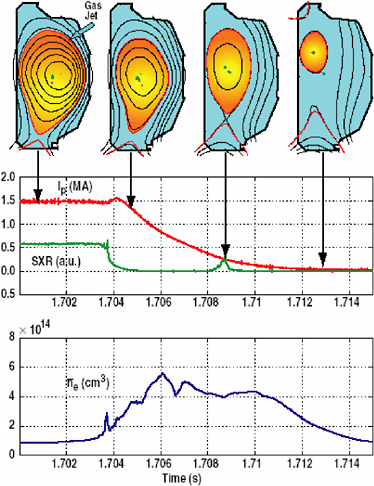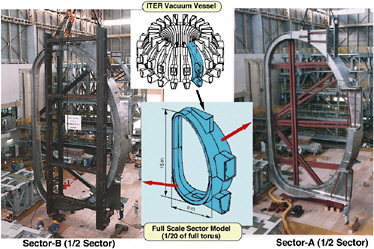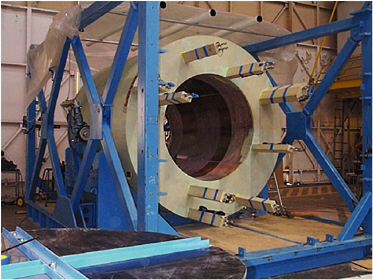3
Readiness for Undertaking a Burning Plasma Experiment
This chapter describes the present state of readiness of the fusion community to undertake a burning plasma experiment. Key criteria that define scientific and technical readiness are identified, and the present state of readiness with respect to each of these criteria is discussed. In analyzing the readiness issues, the ITER design is used as a prototypical example of the burning plasma experiments under consideration; relevant differences for other designs are noted.
A successful burning plasma experiment will provide the opportunity to address most, if not all, of the scientific and technical issues discussed in Chapter 2. With the goal of addressing all of the critical issues in mind, the committee formulated criteria for scientific and technical readiness to proceed with a burning plasma experiment. To say that a criterion is satisfied effectively states that its critical scientific and technical issues can be addressed in the proposed experiment with a reasonable degree of confidence. In the spirit of a scientific experiment, readiness to proceed does not guarantee the performance of the burning plasma under all conditions, but only the accessibility of the desired regime.
The focus of this discussion is on evaluating the readiness to realize an experiment to study the scientific and technical issues identified as important to fusion energy science and the eventual development of fusion energy. But in addition, it is clear that confronting these issues in a burning plasma experiment will provide significant opportunities for addressing the issues of importance to the understanding of plasma physics and physical science in general.
SCIENTIFIC READINESS
The committee found it useful to assess the scientific readiness to undertake a burning plasma experiment in terms of the following six well-defined criteria:
-
Confinement projections,
-
Operational boundaries—plasma pressure and current,
-
Mitigation of abnormal events,
-
Maintenance of plasma purity,
-
Characterization techniques, and
-
Plasma control techniques.
It is the committee’s judgment that each of these six scientific areas must be sufficiently understood before a burning plasma experiment can be positioned for success. Each of these criteria is discussed and analyzed below. As a whole, this analysis allows for an estimate to be made of the state of readiness for undertaking a burning plasma experiment.
Confinement Projections
Reaching the burning plasma regime depends critically on the rate at which energy is lost from the plasma. This energy-loss rate can be projected on the basis of confinement scaling, scaling with similar nondimensional parameters, or models of the plasma transport averaged over magnetic-flux surfaces. Each of these methods of projecting energy-loss rates predicts that ITER will meet the goal of producing 10 times more power via fusion reactions in the plasma than the input power used to heat the plasma (i.e., Q = 10).
It is possible to predict accurately the energy-loss rate in existing tokamak experiments through confinement scaling studies that fit the observed energy confinement time τE (where τE is the reciprocal of the energy-loss rate from the tokamak global database of about a thousand discharges in eight large tokamaks) as a power law in the appropriate discharge parameters. The validity of this technique has been confirmed by results from the new-generation tokamaks. An extrapolation of the energy confinement time by a factor of approximately 3 is required to go from the best confinement time in present large tokamaks to ITER. A relevant measure of fusion performance is the “fusion triple product,” nTτE, which is roughly proportional to the fusion gain factor, Q. Figure 3.1 displays this fusion triple product for tokamak discharges as a function of the value predicted by the scaling analysis. The present database spans three orders of magnitude in nTτE. An extrapolation by an additional factor of 20 is required to reach the nominal ITER operating point corresponding to a fusion gain Q = 10.
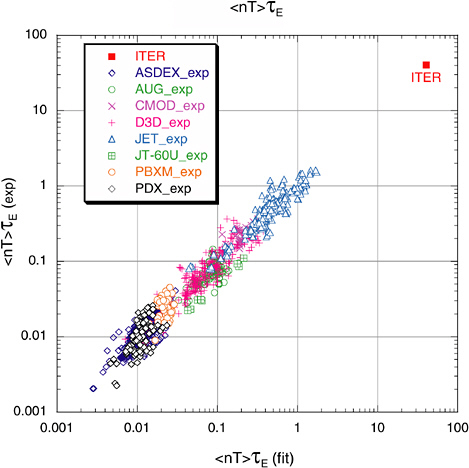
FIGURE 3.1 The fusion triple product, nT τE, in units of 1020 keV-s/m3 from actual experimental discharges versus that projected by confinement scaling studies. Data presented are taken from the International Tokamak Physics Activity (ITPA) high-confinement mode (H-mode) database, the international tokamak database for enhanced confinement discharges similar to those expected in ITER, provided by the ITPA Confinement Database and Modeling group. Note that only results from those experiments that could access this enhanced confinement regime are included in this data compilation. NOTE: Symbols on plot are defined as follows: ITER—International Thermonuclear Experimental Reactor; ASDEX—Axially Symmetric Divertor Experiment; AUG—ASDEX Upgrade Project; CMOD—Alcator C-Mod Tokamak Fusion Research Project; D3D—DIII-D National Fusion Facility; JET—Joint European Torus; JT-60U—flagship tokamak of Japanese magnetic-confinement program; PBXM—Princeton Beta Experiment Modification; and PDX—Poloidal Divertor Experiment. Courtesy of J. DeBoo, General Atomics, and F. Perkins, Princeton Plasma Physics Laboratory.
Scaling with similar nondimensional parameters makes use of the fact that existing tokamaks can simultaneously match all important nondimensional parameters projected for burning plasma discharges, other than the nondimensional size parameter ρ*, which is the ratio of the ion gyroradius to the plasma minor radius. In present experiments, ITER-like values of this parameter cannot be achieved simultaneously with the requisite constraints on the normalized plasma density. The scaling of the energy-loss rate with this size parameter is then inferred by comparing discharges with different values of ρ* in which the remaining nondimensional parameters are held fixed at the values expected in the burning plasma experiment. While this analysis has not been done for the current ITER design, the resulting projection of the confinement time with ρ* nearly matches the projection from the global database scaling for the previous ITER design (i.e., the ITER-Engineering Design Activity).1
These scaling studies provide confidence that the energy confinement in ITER will be sufficient to obtain a fusion gain, Q ≥ 5. The extrapolation from the existing database to the near-reactor conditions accessible in ITER is comparable to the step taken in moving from the midsize experiments in the 1980s to the large tokamaks now in operation. The performance of these existing tokamaks was accurately predicted by the previously existing database. The projections for ITER are able to make use of both considerably refined data from the present generation of large tokamaks and the physics-based dimensionless-parameter scaling technique.
Models based on analyses of plasma instabilities and three-dimensional simulations of fully developed microturbulence can now predict ion thermal diffusion in the plasma core. These transport models have been extensively benchmarked against experimental results.2 Generally, these models reliably predict the thermal transport and the resulting core temperature profiles when provided an appropriate boundary temperature, albeit under conditions in which the ions are hotter than the electrons—in contrast to the situation expected at ITER. At present, there is a lack of adequate theoretical models to predict the temperatures near the plasma boundary, so this parameter is taken from empirical fits to experimental data. While this uncertainty in the edge temperature introduces some uncertainty in the projected fusion gain, the transport models project performance for ITER similar to that predicted by the scaling studies—namely, that ITER will achieve a fusion
gain in the range 5 ≤ Q ≤ 15.3 This analysis of plasma confinement provides an acceptable level of confidence in projecting the performance of ITER.
It is possible that in a burning plasma experiment, new (e.g., nonlinear) interactions will be discovered between the fusion-produced fast alpha particles and the plasma equilibrium and that such interactions could alter the confinement properties of the plasma. A key goal of conducting a burning plasma experiment is to investigate the particle and energy transport in this potentially new regime.
The present level of uncertainty in confinement projections is acceptable for proceeding with a burning plasma experiment.
Operational Boundaries—Plasma Pressure and Current
Tokamak operation is constrained by limits on the plasma pressure and current. Such limits can be calculated within ideal magnetohydrodynamic (MHD) theory and can be avoided through control of the plasma pressure and current. ITER will operate within these limits. Experiments are planned to explore the boundary of this stable regime with the goal of further expanding the burning plasma operating regime. These experiments will be guided by the results of computational models that include dissipative effects and follow the growth and saturation of MHD instabilities at the boundaries of the stable operating regime. Examples of this MHD modeling capability are shown in Figures 3.2 and 3.3. Such modeling contributes to an understanding of whether the consequence of violating a particular operational boundary will be a degradation in performance or a catastrophic loss of confinement followed by a disruption of the plasma current.
Within this stable operating regime, there is another instability, called the neoclassical tearing mode, that can degrade plasma performance. This instability depends strongly on the dissipation and transport properties of the plasma. Although the theory for the neoclassical tearing mode is still developing and the stability boundary cannot yet be predicted with precision, an important recent development is the discovery of a method to stabilize the plasma using localized, microwave-driven currents. This stabilization technique is understood theoretically. The planned addition of microwave-based current-drive capabilities in ITER is expected to provide a means of stabilizing these modes, should that prove necessary (see Figure 3.4).
There is a limit to the plasma density that is proportional to the plasma current, and it is characterized empirically. It is planned that ITER will operate below
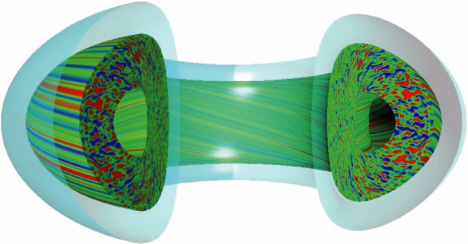
FIGURE 3.2 Contours of constant potential from a computer simulation of plasma turbulence in the DIII-D tokamak using the GYRO code. Note that the turbulent eddies are elongated along the magnetic field, while shear in the plasma electric and magnetic field (E × B) rotation prevents structures with a cross-field dimension greater than ~10σi from forming. Courtesy of General Atomics.
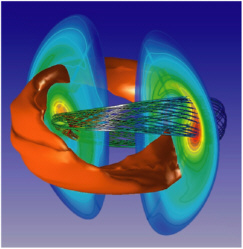
FIGURE 3.3 A spherical tokamak with a saturated magnetic island due to sheared toroidal rotation, as predicted by the M3D code. Courtesy of W. Park, Princeton Plasma Physics Laboratory.
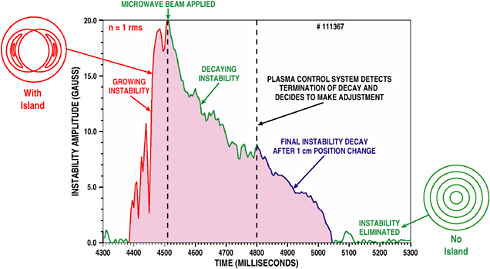
FIGURE 3.4 Time evolution of neoclassical tearing mode and response of the plasma control system. Applying and adjusting the precise position at which the microwave power is deposited stops the growth of a neoclassical tearing mode and then eliminates it. Courtesy of General Atomics.
this density limit. However, since fusion power gain generally increases with plasma density, developing a predictive understanding of this limit and methods to circumvent it could potentially yield great benefit.
The present operational boundaries and other constraints, including limits on plasma pressure (i.e., “beta”) and current, must be and are sufficiently well understood to proceed with a burning plasma experiment.
Mitigation of Abnormal Events
Burning plasma experiments are designed to safely handle abnormal events such as disruptions, should they occur. Recent experiments have shown that disruptions can be avoided by operating below established stability limits. If excursions beyond these safe operating limits should occur, new techniques, such as the injection of argon gas, may be used to quench the plasma and avoid damage due to runaway electrons and reduce erosion due to high heat fluxes (see Figure 3.5). Model calculations indicate that this gas-injection technique will be applicable on
the larger plasmas in ITER.4 Research should continue to extend these results to larger plasmas and further validate the gas-penetration models. Further experiments are also needed to confirm that “thermal-quench” damage to the walls and/ or divertor plates can simultaneously be avoided.
There is an instability near the plasma edge, the edge-localized mode (ELM), that can cause large and repetitive heat loads on plasma-facing components and, in turn, can severely limit component lifetimes. While a predictive understanding of these modes is still in development, experiments have now identified regimes with good plasma performance and with either significantly reduced or no edge-localized oscillations. These results provide some level of confidence that the deleterious effects of these ELMs can be avoided. However, further research and development are required, both to better understand these edge-localized modes and to develop reliable methods to mitigate peak heat loads without degrading burning plasma performance.
There must be sufficient confidence that disruptions and other abnormal events can be avoided or mitigated. While there is such confidence, further research and development are needed to develop plasma operating regimes that present less stringent heat loads to plasma-facing components.
Maintenance of Plasma Purity
The introduction of impurities into the plasma, either as helium from fusion reactions or from sputtered first-wall materials, can significantly degrade plasma performance. Experiments have demonstrated that these impurities can be successfully removed from the plasma as neutral gas, formed when plasma recombines in the divertor. Experiments and modeling of the edge plasma and scrape-off layer increase confidence that the production of impurities and their influx into the plasma can be maintained within acceptable limits, although the physical models for the plasma edge region need further refinement. Since most of these observations are empirical, further work on developing theoretical models of impurity and ash transport in the plasma core region is needed. This impurity-removal issue is especially important for advanced tokamak operating regimes in which the ion (and impurity) confinement in the plasma core is considerably improved.
There must be sufficient confidence that the required plasma purity can be obtained, including the removal of helium and the inhibition of impurity influx from the first wall and divertor. There is such confidence.
Characterization Techniques
The scientific evaluation of a burning plasma experiment requires the reliable measurement of key quantities with good spatial and temporal resolution in a high-neutron environment. Important factors include adequate diagnostic access and the remote maintenance of measurement instruments. There is confidence that most of these measurements can be made with adequate precision, assuming appropriate flexibility in the design of the burning plasma device. Topics for further R&D as part of the burning plasma program include measurements of the distribution of fusion alpha particles, the plasma current profile, and the properties of the plasma turbulence.
Techniques must be, and are, available to adequately characterize and evaluate most of the important parameters in a burning plasma.
Plasma Control Techniques
ITER has both been designed to and is expected to achieve the key goal of studying the burning plasma regime in a conventional high-confinement (H-mode) regime. While many of the important scientific issues relating to burning plasmas can be addressed in this regime, the ability to operate in a high-performance regime—the so-called advanced tokamak regime—will be an important step on the path to an economically attractive fusion power plant.
Experiments in auxiliary-heated tokamaks have demonstrated that operational limits can be significantly extended through control of the plasma pressure and current profiles. The experimental program for ITER includes exploration of this advanced tokamak regime, in which control of the pressure and current profiles presents additional challenges. The complexity arises from nonlinear interactions between the pressure profile, the heating source (proportional to the square of the plasma pressure), the self-driven currents (proportional to the pressure gradients), and turbulent transport (which depends on the pressure, the pressure gradient, and the current profile). The plasma control tools required to begin studies of this regime are largely in hand. However, there is need for further research and development on fueling the central plasma (for pressure-profile control) and control of plasma rotation (for stabilization of resistive wall modes). Further research
and development are required to develop methods to control plasma transport (including the control of internal transport barriers) and the interaction of radio-frequency heating sources with fusion alpha particles in the advanced tokamak regime. Research should also continue to develop techniques to stabilize resistive wall modes with feedback and to control both the electron density and electron-density profile.
There must be plasma control techniques that are adequate to produce and evaluate burning plasma physics and to explore steady-state advanced operational regimes. Such techniques have been developed.
Conclusion
In the past several years, significant progress has been made in the understanding and control of fusion plasmas through advances in a broad range of critical scientific issues. Small, focused experiments have led to critical understanding of issues such as the self-driven bootstrap currents necessary to efficiently sustain fusion-grade tokamak plasmas. Larger-scale facilities are also successfully developing key concepts for more attractive fusion energy concepts and for the control of fusion plasmas. All of these scientific developments positively impact the potential for developing an attractive fusion concept, as well as increasing our fundamental understanding of the plasma state of matter. This type of progress in fusion science and fusion technology has led to confidence that the global fusion community is scientifically ready to take the burning plasma step.
TECHNICAL READINESS
The need to assess the technical readiness for an experiment such as ITER is as important as understanding the scientific readiness to undertake a burning plasma experiment. In this section, the following six criteria that define technical readiness to create and study burning plasmas are considered:
-
Fabrication of necessary components,
-
Component lifetime in a nuclear environment,
-
Lifetime of plasma-facing components,
-
Tritium inventory control,
-
Remote maintenance, and
-
Fueling, heating, and current drive control.
Fabrication of Necessary Components
The required techniques for fabricating components for ITER have been successfully demonstrated with prototypes (see Figures 3.6 and 3.7). Successful prototype components5 have been built for all major systems, including full-scale vacuum-vessel sectors.6,7 The magnet coil designs have been verified to meet the field requirements with a good engineering safety margin.8 Scenarios for remote fabrication and repair have also been tested.
The necessary components for ITER can be manufactured and assembled, including the required magnetic field coils, the vacuum vessel, divertor, and first-wall components.
Component Lifetime in a Nuclear Environment
The lifetime of the various parts of a working fusion reactor must be shortened as little as possible by damage from operating in a nuclear environment. The design of a burning plasma device must include adequate shielding for the magnetic field coils; thus, research is continuing to improve the radiation resistance of electrical insulators to permit increased mission life. This effort will be particularly important for insulators in copper-coil designs in order to optimize the number of full-power discharges.9 Further research and development are needed for diagnostics, including those sited in high-neutron-flux areas and those requiring transparent optical materials. Further research is required to develop beam-based fluctuation diagnostics for a burning plasma experiment.
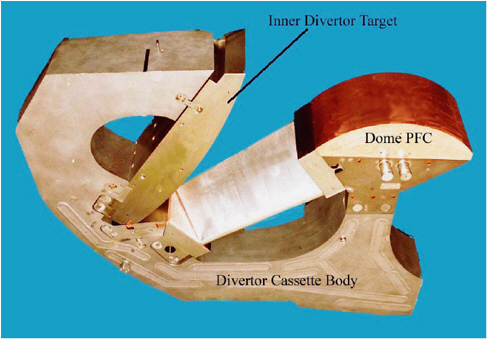
FIGURE 3.8 Prototype of a divertor plasma-facing component (PFC) for ITER. Courtesy of ITER.
There is sufficient assurance that major components can survive in the required nuclear environments.
Lifetime of Plasma-Facing Components
Prototype designs of plasma-facing components (see Figure 3.8) have been tested for normal heat-flux conditions, and it has been demonstrated that the mechanical designs can accommodate the projected disruption forces.10 Both carbon-based materials and refractory metals (e.g., tungsten and molybdenum) have
been qualified for fusion devices. Techniques have been developed to mitigate the heat loads expected from plasma disruptions in order to ensure component integrity and sufficient erosion lifetimes. The one exception is the case of edge-localized modes typical of the highest-performance plasmas. These instabilities can cause rapid and repetitive deposition of energy to the plasma-facing components. The resulting erosion greatly shortens component lifetimes. Experiments have shown that some mitigation is possible by plasma shaping and edge density control with little loss of confinement. Further research on the mitigation of these edge instabilities is required.
Plasma-facing components can be designed and built to handle the anticipated heat flux, particle flux, and mechanical stresses necessary for use in a burning plasma experiment, including those experienced during most disruptive discharge terminations.
Tritium Inventory Control
Safety analyses have found that all of the proposed burning plasma devices meet fusion safety standards, and none of the devices requires an evacuation plan beyond the site boundary. There are proven techniques11 for separating hydrogen isotopes, cleaning up tritium gas, and delivering deuterium and tritium to the plasma. In the case of ITER, the throughput, tritium inventory, and processing rate must all be increased by a factor of 10 to meet the design specifications. In addition, experiments have shown that eroded and redeposited material from carbon components (currently the material of choice for plasma-facing components) traps unacceptably large amounts of tritium. In this key area, further research will be required.
The required tritium inventory can be handled safely, but further research is required to develop plasma-facing components that can reduce the tritium inventory.
Remote Maintenance
Successful remote handling of in-vessel components has been accomplished on the Joint European Torus. Full-size prototypes of major remote handling systems for a burning plasma experiment have been designed and tested. Optimization of the designs for specific burning plasma devices is continuing.
The remote maintenance required to operate a burning plasma experiment can be accomplished.
Fueling, Heating, and Current Drive Control
The injection of frozen pellets of deuterium-tritium is a proven method for fueling fusion plasmas. The use of ion cyclotron heating, electron cyclotron heating and profile control, and lower hybrid heating and current drive are well established. Techniques to use high-energy, negative-ion, neutral-beam heating to heat fusion plasmas have been developed in Japan. Various plasma heating and current drive systems require antennas, waveguides, and mirrors near the plasma (see Figure 3.9 for performance of one example). The choice of structural materials, insulators, and guard materials for these structures is still being optimized.
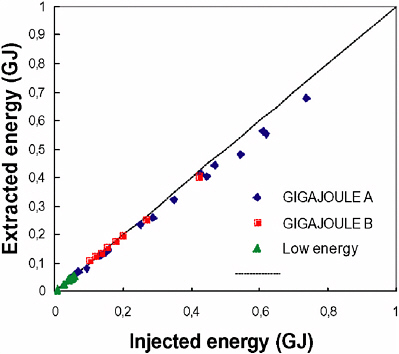
FIGURE 3.9 Results of experiments using an actively cooled limiter on the Tore Supra tokamak in Cadarache, France. Calorimetry has proven to be a valuable tool to confirm injected energy values, as all actively cooled components are equipped with temperature sensors. The balance between injected and extracted energy presented here shows excellent agreement: More than 95 percent of the injected energy is recovered. SOURCE: J. Jacquinot, in “Recent Developments Towards Steady State Physics and Technology of Tokamaks in Cadarache,” Proceedings of the 19th International Atomic Energy Agency Fusion Energy Conference, Lyon, France, October 2002; forthcoming in Nuclear Fusion, Winter 2003. Courtesy of J. Jacquinot, Euratom-Commissariat à l’Énergie Atomique (CEA), CEA Cadarache; Tore Supra, France; and International Atomic Energy Agency.
Adequate fueling, heating, and current drive techniques have been developed to control and evaluate burning plasmas.
Conclusion
The committee finds that the six technical criteria discussed above have now been satisfied, except for a few remaining areas (described in Chapter 4—see the subsection entitled “Directly Support the Burning Plasma Program on ITER”), in which ongoing research is expected to adequately address these outstanding issues.
Significant progress has been made in the development of the technology needed to implement a fusion machine of the scale and nature of ITER. It is clear that ongoing research can be expected to adequately address technical issues requiring continued attention, but no issues remain that would undermine the fusion community’s assertion that it is technically ready to undertake a burning plasma experiment. It is worth noting that many of the confidence-building steps mentioned here were accomplished by researchers outside the United States at fusion research facilities in Europe, Japan, and the Russian Federation, with U.S. participation during the ITER Engineering Design Activity and prototype testing prior to U.S. withdrawal from the ITER program in 1998.

